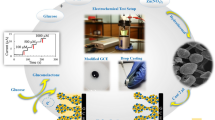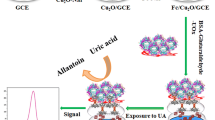Abstract
An enzyme-free electrochemical sensor platform is reported based on hollow sphere structured nickel sulfide (HS-NiS) nanomaterials for the sensitive lactic acid (LA) detection in human urine. Hollow sphere nickel sulfide nanostructures directly grow on the nickel foam (NiF) substrate by using facile and one-step electrochemical deposition strategy towards the electrocatalytic lactic acid oxidation and sensing for the first time. The as-developed nickel sulfide nanostructured electrode (NiF/HS-NiS) has been successfully employed as the enzyme mimic electrode towards the enhanced electrocatalytic oxidation and detection of lactic acid. The NiF/HS-NiS electrode exhibits an excellent electrocatalytic activity and sensing ability with low positive potential (~ 0.52 V vs Ag/AgCl), catalytic current density (~ 1.34 mA), limit of detection (LOD) (0.023 μM), linear range from 0.5 to 88.5 μM with a correlation coefficient of R2 = 0.98, sensitivity (0.655 μA μM−1 cm−2), and selectivity towards the lactic acid owing to the ascription of high inherent electrical conductivity, large electrochemical active surface area (ECASA), high electrochemical active sites, and strong adsorption ability. The sensors developed in this work demonstrate the selectivity against potential interferences, including uric acid (UA), ascorbic acid (AA), paracetamol (PA), Mg2+, Na+, and Ca2+. Furthermore, the developed sensors show practicability by sensing lactic acid in human urine samples, suggesting that the HS-NiS nanostructures device has promising clinical diagnostic potential.

Graphical abstract






Similar content being viewed by others
References
Bobade S, Kalorey DR, Warke S (2016) Biosensor devices: a review on their biological applications. Biosci Biotechnol Res Commun 9:132–137. https://doi.org/10.21786/bbrc/19.1/20
Govindhan M, Adhikari BR, Chen A (2014) Nanomaterials-based electrochemical detection of chemical contaminants. RSC Adv 4:63741–63760. https://doi.org/10.1039/c4ra10399h
Krishnan SK, Singh E, Singh P, Meyyappan M, Nalwa HS (2019) A review on graphene-based nanocomposites for electrochemical and fluorescent biosensors. RSC Adv 9:8778–8781. https://doi.org/10.1039/c8ra09577a
Napi MLM, Sultan SM, Ismail R, How KW, Ahmad MK (2019) Electrochemical-based biosensors on different zinc oxide nanostructures: a review. Materials (Basel) 12:1–34. https://doi.org/10.3390/ma12182985
Shavanova K, Bakakina Y, Burkova I, Shtepliuk I, Viter R, Ubelis A, Beni V, Starodub N, Yakimova R, Khranovskyy V (2016) Application of 2D non-graphene materials and 2D oxide nanostructures for biosensing technology. Sensors (Switzerland) 16:1–23. https://doi.org/10.3390/s16020223
Khan I, Saeed K, Khan I (2019) Nanoparticles: properties, applications and toxicities. Arab J Chem 12:908–931. https://doi.org/10.1016/j.arabjc.2017.05.011
Ansari AA, Alhoshan M, Alsalhi MS, Aldwayyan AS (2010) Nanostructured metal oxides based enzymatic electrochemical biosensors. Biosensors. https://doi.org/10.5772/7201
Huang H, Su S, Wu N, Wan H, Wan S, Bi H, Sun L (2019) Graphene-based sensors for human health monitoring. Front Chem 7:1–26. https://doi.org/10.3389/fchem.2019.00399
Monosik R, Stredansky M, Tkac J, Sturdik E (2012) Application of enzyme biosensors in analysis of food and beverages. Food Anal Methods 5:40–53. https://doi.org/10.1007/s12161-011-9222-4
Dandan Z, Ke Z, Minghui Y (2019) Gold nanoparticle-loaded hollow Prussian blue nanoparticles with peroxidase-like activity for colorimetric determination of L-lactic acid. Microchim Acta 186(2):121
Abdul SC, Nusrat NM, Sidra A, Fouzia C, Umair A, Muhammad I et al (2019) Facile non-enzymatic lactic acid sensor based on cobalt oxide nanostructures. Electroanalysis 31(7):1296–1303
Yao Y, Li H, Wang D, Liu C, Zhang C (2017) An electrochemiluminescence cloth-based biosensor with smartphone-based imaging for detection of lactate in saliva. Analyst 142:3715–3724. https://doi.org/10.1039/c7an01008g
Prakash S, Chakrabarty T, Singh AK, Shahi VK (2013) Polymer thin films embedded with metal nanoparticles for electrochemical biosensors applications. Biosens Bioelectron 41:43–53. https://doi.org/10.1016/j.bios.2012.09.031
Seenivasan R, Chang W, Gunasekaran S (2015) Highly sensitive detection and removal of lead ions in water using cysteine-functionalized graphene oxide/polypyrrole nanocomposite film electrode. https://doi.org/10.1021/acsami.5b03904
Lawal AT (2018) Author’ s accepted manuscript. Biosens Bioelectron 106:149–178. https://doi.org/10.1016/j.bios.2018.01.030
Zhao F, Zeng J, Shih WC (2017) Nanoporous gold nanocomposites as a versatile platform for plasmonic engineering and sensing. Sensors (Switzerland) 17:1–11. https://doi.org/10.3390/s17071519
Betancourt T, Brannon-Peppas L (2006) Micro-and nanofabrication methods in nanotechnological medical and pharmaceutical devices. Int J Nanomedicine 1:483–495. https://doi.org/10.2147/nano.2006.1.4.483
Malekian B, Xiong K, Emilsson G, Andersson J, Fager C, Olsson E, Larsson-Langhammer E, Dahlin A (2017) Fabrication and characterization of plasmonic nanopores with cavities in the solid support. Sensors (Switzerland) 17:1–11. https://doi.org/10.3390/s17061444
Ahmad R, Wolfbeis OS, Hahn YB, et al (2018) Deposition of nanomaterials: a crucial step in biosensor fabrication
Othman A, Karimi A, Andreescu S (2016) Functional nanostructures for enzyme based biosensors: properties, fabrication and applications. J Mater Chem B 4:7178–7203. https://doi.org/10.1039/C6TB02009G
Govindhan M, Chen A (2016) Enhanced electrochemical sensing of nitric oxide using a nanocomposite consisting of platinum-tungsten nanoparticles, reduced graphene oxide and an ionic liquid. Microchim Acta 183:2879–2887. https://doi.org/10.1007/s00604-016-1936-y
Govindhan M, Amiri M, Chen A (2015) Au nanoparticle/graphene nanocomposite as a platform for the sensitive detection of NADH in human urine. Biosens Bioelectron 66:474–480. https://doi.org/10.1016/j.bios.2014.12.012
Pereira TC, Stradiotto NR (2019) Electrochemical sensing of lactate by using an electrode modified with molecularly imprinted polymers, reduced graphene oxide and gold nanoparticles. Microchim Acta 186(12):764
Dandan Z, Congsen W, Junjun L, Minghui YD (2019) C3N4 nanosheet-supported Prussian blue nanoparticles as a peroxidase mimic: colorimetric enzymatic determination of lactate. Microchim Acta 186(11):735
Tonelli D, Scavetta E, Gualandi I (2019) Electrochemical deposition of nanomaterials for electrochemical sensing. Sensors (Switzerland) 19. https://doi.org/10.3390/s19051186
Wang J (2012) Electrochemical biosensing based on noble metal nanoparticles. Microchim Acta 177:245–270. https://doi.org/10.1007/s00604-011-0758-1
Xia X, Zhang Y, Chao D, Guan C, Zhang Y, Li L, Ge X, Bacho IM, Tu J, Fan HJ (2014) Solution synthesis of metal oxides for electrochemical energy storage applications. Nanoscale 6:5008–5048. https://doi.org/10.1039/c4nr00024b
Li H, Huang M, Cao G (2017) Magnetic properties of atomic 3d transition-metal chains on S-vacancy-line templates of monolayer MoS2: effects of substrate and strain. J Mater Chem C 5:4557–4564. https://doi.org/10.1039/c6tc04672j
Wang Y, Guo J, Wang T, Shao J, Wang D, Yang YW (2015) Mesoporous transition metal oxides for supercapacitors. Nanomaterials 5:1667–1689. https://doi.org/10.3390/nano5041667
Chen H, Jiang J, Zhang L, Wan H, Qi T, Xia D (2013) Highly conductive NiCo2S4 urchin-like nanostructures for high-rate pseudocapacitors. Nanoscale 5:8879–8883. https://doi.org/10.1039/c3nr02958a
Verma M, Yadav R, Sinha L, Mali SS, Hong CK, Shirage PM (2018) Pseudocapacitive-battery-like behavior of cobalt manganese nickel sulfide (CoMnNiS) nanosheets grown on Ni-foam by electrodeposition for realizing high capacity. RSC Adv 8:40198–40209. https://doi.org/10.1039/C8RA07471B
Feng LL, Yu G, Wu Y, Li GD, Li H, Sun Y, Asefa T, Chen W, Zou X (2015) High-index faceted Ni3S2 nanosheet arrays as highly active and ultrastable electrocatalysts for water splitting. J Am Chem Soc 137:14023–14026. https://doi.org/10.1021/jacs.5b08186
Li X, Shang X, Rao Y, Dong B, Han GQ, Hu WH, Liu YR, Yan KL, Chi JQ, Chai YM, Liu CG (2017) Tuning crystal phase of NiS x through electro-oxidized nickel foam: a novel route for preparing efficient electrocatalysts for oxygen evolution reaction. Appl Surf Sci 396:1034–1043. https://doi.org/10.1016/j.apsusc.2016.11.084
Pang H, Wei C, Li X, Li G, Ma Y, Li S, Chen J, Zhang J (2014) Microwave-assisted synthesis of NiS2 nanostructures for supercapacitors and cocatalytic enhancing photocatalytic H2 production. Sci Rep 4:1–8. https://doi.org/10.1038/srep03577
Jana S, Samai S, Mitra BC, Bera P, Mondal A (2014) Nickel oxide thin film from electrodeposited nickel sulfide thin film: peroxide sensing and photo-decomposition of phenol. Dalton Trans 43:13096–13104. https://doi.org/10.1039/c4dt01658k
Chhetri M, Sultan S, Rao CNR (2017) Electrocatalytic hydrogen evolution reaction activity comparable to platinum exhibited by the Ni/Ni(OH) 2 /graphite electrode. Proc Natl Acad Sci U S A 114:8986–8990. https://doi.org/10.1073/pnas.1710443114
Bhosale R, Kelkar S, Parte G, Fernandes R, Kothari D, Ogale S (2015) NiS1.97: a new efficient water oxidation catalyst for photoelectrochemical hydrogen generation. ACS Appl Mater Interfaces 7:20053–20060. https://doi.org/10.1021/acsami.5b05077
Tong F, Wu X, Jia W, Guo J, Pan Y, Lv Y, Jia D, Zhao X (2020) NiS nanosheets with novel structure anchored on coal-based carbon fibers prepared by electrospinning for flexible supercapacitors. CrystEngComm. 22:1625–1632. https://doi.org/10.1039/c9ce01560d
Wang XD, Xu YF, Rao HS, Xu WJ, Chen HY, Zhang WX, Kuang DB, Su CY (2016) Novel porous molybdenum tungsten phosphide hybrid nanosheets on carbon cloth for efficient hydrogen evolution. Energy Environ Sci 9:1468–1475
Elakkiya R, Maduraiveeran G (2019) A three-dimensional nickel-cobalt oxide nanomaterial as an enzyme-mimetic electrocatalyst for the glucose and lactic acid oxidation reaction. New J Chem 43:14756–14762
Gao W, Yin H, Nyein Y et al (2016) Heavy metal monitoring of body fluids a wearable microsensor array for multiplexed heavy metal monitoring of body fluids. https://doi.org/10.1021/acssensors.6b00287
Bravo I, Revenga-Parra M, Pariente F, Lorenzo E (2017) Reagent-less and robust biosensor for direct determination of lactate in food samples. Sensors (Switzerland) 17:1–11. https://doi.org/10.3390/s17010144
Shankar SS, Shereema RM, Rakhi RB (2018) Electrochemical determination of adrenaline using MXene/graphite composite paste electrodes. ACS Appl Mater Interfaces 10:43343–43351. https://doi.org/10.1021/acsami.8b11741
Gamero M, Sosna M, Pariente F, Lorenzo E, Bartlett PN, Alonso C (2012) Influence of macroporous gold support and its functionalization on lactate oxidase-based biosensors response. Talanta 94:328–334. https://doi.org/10.1016/j.talanta.2012.03.051
Giménez-Gómez P, Gutiérrez-Capitán M, Capdevila F, Puig-Pujol A, Fernández-Sánchez C, Jimenez-Jorquera C (2017) Miniaturized flow-system integrating enzymatic electrochemical biosensors for monitoring the malolactic fermentation of red wines. Proceedings 1:787. https://doi.org/10.3390/proceedings1080787
Jiang D, Chu Z, Peng J, Jin W (2016) Screen-printed biosensor chips with Prussian blue nanocubes for the detection of physiological analytes. Sensors Actuators B Chem 228:679–687. https://doi.org/10.1016/j.snb.2016.01.076
Mohiuddin M, Arbain D, Islam AKMS, Ahmad MS, Ahmad MN (2016) Alpha-glucosidase enzyme biosensor for the electrochemical measurement of antidiabetic potential of medicinal plants. Nanoscale Res Lett 11:1–12. https://doi.org/10.1186/s11671-016-1292-1
Nesakumar N, Sethuraman S, Krishnan UM, Rayappan JBB (2013) Fabrication of lactate biosensor based on lactate dehydrogenase immobilized on cerium oxide nanoparticles. J Colloid Interface Sci 410:158–164. https://doi.org/10.1016/j.jcis.2013.08.009
Pereira AC, Aguiar MR, Kisner A, Macedo DV, Kubota LT (2007) Amperometric biosensor for lactate based on lactate dehydrogenase and Meldola blue coimmobilized on multi-wall carbon-nanotube. Sensors Actuators B Chem 124:269–276. https://doi.org/10.1016/j.snb.2006.12.042
Teymourian H, Salimi A, Hallaj R (2012) Low potential detection of NADH based on Fe 3O 4 nanoparticles/multiwalled carbon nanotubes composite: fabrication of integrated dehydrogenase-based lactate biosensor. Biosens Bioelectron 33:60–68. https://doi.org/10.1016/j.bios.2011.12.031
Miraida P, Dámaris S, Nicole del T, Kai G (2015) A comparative study of different protein immobilization methods for the construction of an efficient nano-structured lactate oxidase-SWCNT-biosensor, Biosens Bioelectron 64:138–146
Takeshi S, Touru S, Masatoshi O, Tetsuji I, Taka-aki H (2012) Amperometric l-lactate biosensor based on screen-printed carbon electrode containing cobalt phthalocyanine, coated with lactate oxidase-mesoporous silica conjugate layer. Anal Chim Acta 714:114–120
Sidra A, Aneela T, Amber S, Raffaello M, Zafar Hussain I, Alberto V (2019) A sensitive enzyme-free lactic acid sensor based on NiO nanoparticles for practical applications, anal. Methods 11:3578
Acknowledgements
Authors specially acknowledge to SRM Institute of Science and Technology (SRM IST) for providing all the research facilities, including SRM-SCIF for TEM measurements.
Funding
This work was supported by the Science and Engineering Research Board (SERB)-Start-up Research Grant (Ref. No.: SERB-SRG/2019/000123) and the Department of Science and Technology (DST)-Technology Mission Division (TMD) (Grant No.: DST/TMD/MES/2 K17/29), New Delhi.
Author information
Authors and Affiliations
Corresponding author
Ethics declarations
Conflict of interest
The author(s) declare that they have no competing interests.
Additional information
Publisher’s note
Springer Nature remains neutral with regard to jurisdictional claims in published maps and institutional affiliations.
Electronic supplementary material
ESM 1
(DOCX 1161 kb)
Rights and permissions
About this article
Cite this article
Arivazhagan, M., Shankar, A. & Maduraiveeran, G. Hollow sphere nickel sulfide nanostructures–based enzyme mimic electrochemical sensor platform for lactic acid in human urine. Microchim Acta 187, 468 (2020). https://doi.org/10.1007/s00604-020-04431-3
Received:
Accepted:
Published:
DOI: https://doi.org/10.1007/s00604-020-04431-3




